Manganese in water has several unwanted aesthetic effects. In high concentrations, it gives water a bitter taste or an unappealing dark brown or black tinge, and you may notice stains on fixtures and appliances that come into contact with your water.
At Water Filter Guru, we’re committed to testing all the different water treatment technologies that address a range of common contaminants in tap water. In this guide, we’re sharing the best ways to filter manganese out of your water, based on our own testing and data we’ve obtained from scientific studies published online.
📌 Key Takeaways
- Oxidation media, air or chemical injection & filtration, cation exchange, and reverse osmosis, are all the best ways to reduce manganese in water.
- Boiling water, activated carbon, activated alumina, and catalytic carbon are NOT effective methods of manganese removal.
Table of Contents
📥 Air Injection & Oxidation (Aeration)
Manganese reduction rate: Up to 5-7 PPM
Air injection, otherwise known as aeration, is one of the best water treatment methods for exclusively targeting manganese, iron, and hydrogen sulfide contamination.
Air injection systems are point-of-entry units that typically target up to 5-7 PPM of manganese in water.
How it Works
In an air injection system, water is sent through a pocket of air to oxidize manganese, as well as dissolved iron concentrations and hydrogen sulfide.
In its oxidized form, the manganese and other minerals can be captured in a filtration media. Most air injection systems use a tank containing birm or manganese greensand media, which traps the oxidized minerals as water flows through the tank.
The minerals can be removed from the tank with periodic backwashing, allowing the filtration media to be used over an extended period before it needs to be replaced. The tank is also replenished with a fresh air pocket.
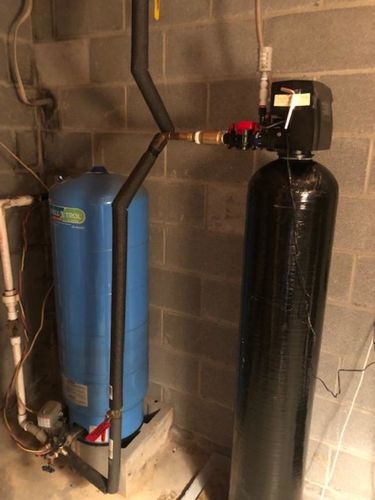
The Evidence
We couldn’t find any studies that specifically focused on the effectiveness of air injection/oxidation for manganese reduction in at-home water treatment systems. But we still came across some interesting research about aeration for manganese reduction:
- A 2021 evaluation of iron and manganese removal effectiveness by treatment plant modules found that those using open-aeration and chlorine as oxidants were the “most effective” in removing manganese.
- This 2016 study of methods that oxidize and remove manganese and iron noted that aeration alone (without an oxidation media) had an average manganese reduction rate of 30%.
Best For
Air injection or aeration systems are the most suitable solution for people with well water who want to address higher concentrations of manganese, alongside iron and hydrogen sulfide, with a dedicated POE water treatment system.
⚗️ Chemical Oxidation
Manganese reduction rate: Up to 10 PPM
Chemical oxidation works off the same concept as aeration or air injection, except with this method, water is exposed to a chemical oxidant rather than an air bubble.
This process can remove higher concentrations of manganese – we’ve reviewed chemical injection systems that can reduce manganese concentrations up to 10 PPM – as well as iron and hydrogen sulfide.
Additionally, chemicals like chlorine kill microorganisms like bacteria, so they also have disinfection benefits when used for water treatment.
How it Works
A chemical injection/oxidation system injects a measured concentration of an oxidizing chemical into the water. Chemicals used for this purpose include chlorine, ozone, potassium permanganate, and hydrogen peroxide.
The outcome is the same: manganese, iron, and hydrogen sulfide are converted into an insoluble form, which can then be removed with a filtration media.
There may also be a dedicated filtration stage, such as granular activated carbon, to remove the chemical that was used for oxidizing purposes.
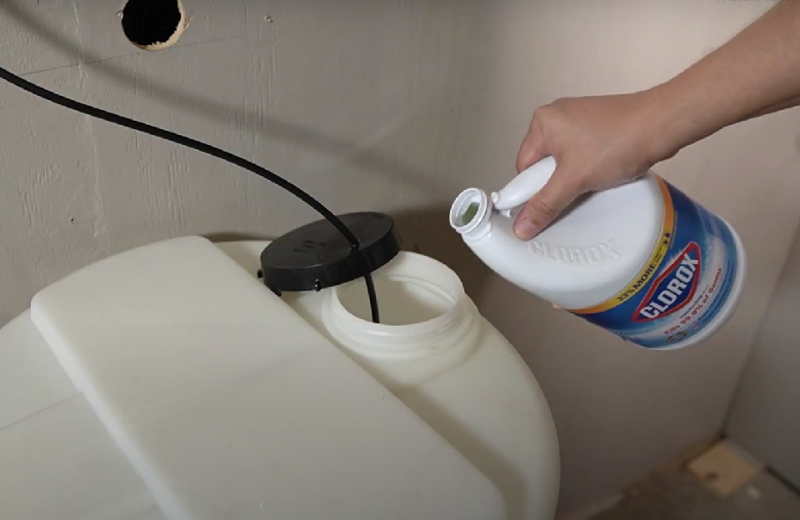
The Evidence
- A 2019 study on the removal of manganese from acid mine wastewater noted that chemical oxidation of manganese can be accelerated by using “strong oxidizing chemicals” like chlorine dioxide, potassium permanganate, or ozone, but noted several setbacks of these chemicals, including the production of byproducts when using chlorine.
- This 2019 North Dakota State University report on removing iron and manganese from water lists chemical oxidation and filtration as “the accepted method of iron and manganese removal” when these minerals are present in concentrations exceeding 10 PPM or mg/L.
Best For
Chemical oxidation is the best all-in-one solution for people with well water who want to reduce manganese, iron, and sulfur and protect their water against microbiological contamination.
🚰 Oxidation Media
Manganese reduction rate: 0.2-1 PPM
Oxidation media oxidizes and filters manganese at the same time.
Manganese greensand and birm are the two most commonly used oxidation media for reducing manganese, iron, and sulfur in drinking water.
The most popular oxidizing media, manganese greensand, addresses lower concentrations of manganese compared to other methods; around 0.2-1 PPM at most.
How it Works
Manganese greensand contains an active material called glauconite, and undergoes chemical treatment that makes it effective at catalyzing the oxidation of soluble manganese and iron.
As water travels through the greensand filter, manganese and iron are captured by the filter media, and oxidize into insoluble forms.
Birm also has the ability to oxidize small amounts of iron, but it’s most effective when used after aeration.
You’ll need to backwash a birm filter or greensand bed with potassium permanganate solution to regenerate the filter media and remove the oxidized manganese particles.
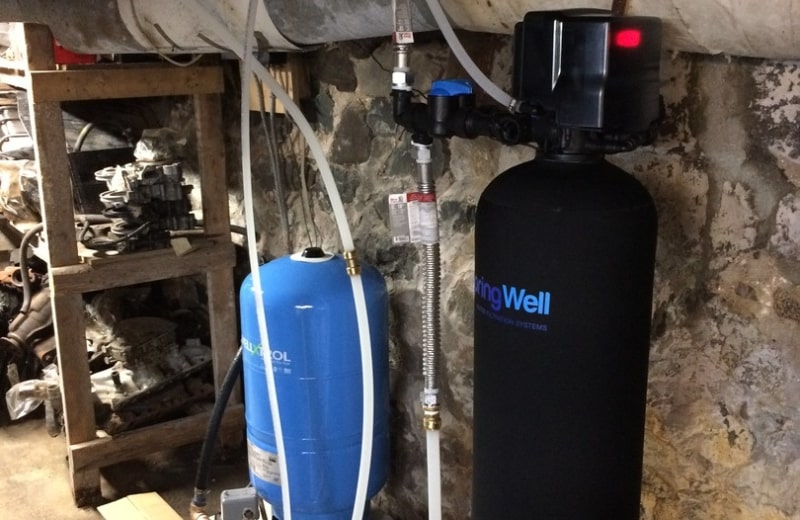
The Evidence
- A 2018 testing report examined the effectiveness of potassium permanganate injection and manganese greensand filtration for manganese reduction. It recorded that 92.5% of the insoluble manganese and 71.4% of the remaining soluble manganese were adsorbed and removed by the greensand filters.
- Filtration using manganese dioxide–coated media, such as manganese greensand, is referenced by the Americal Water Works Association in the Iron and Manganese Removal Handbook as a historically used method of oxidizing and capturing manganese in drinking water.
Best For
Treatment systems using oxidation media have the advantage of being simpler in design; they only require a single media-loaded tank with a backwashing function. That makes them better for folks who want a dedicated treatment method for reducing lower levels of manganese and iron without the additional maintenance of air injection or a chemical feed pump.
🔀 Cation Exchange
Manganese reduction rate: Around 1-2 PPM typically
You probably don’t immediately think of water softening systems when you imagine manganese removal from water, but whole-home water softeners can also reduce low concentrations of cationic iron and manganese alongside hardness minerals.
Water softeners are cation exchange systems, so they can reduce manganese in ionic form, not manganese as a suspended solid in water.
How it Works
Cation exchange typically takes place in a water softener.
During this ion exchange process, positively charged calcium and magnesium ions are attracted to a resin bed, which has a negative charge. The resin releases sodium ions into the water to take the place of the hardness minerals, balancing its charge.
While the primary purpose of water softening is hardness reduction, iron and manganese are also positively charged cations, so low levels of these minerals can be captured in the softening resin.
A water softener regenerates periodically, which flushes the softening resin to remove the accumulated hardness ions and replenish the sodium ions.
There are a few conditions that need to be met for a water softener to effectively reduce manganese:
- Your water should have a pH of greater than 6.7 and contain dissolved oxygen
- And preferably, your iron concentrations should be less than 5 mg/L or PPM
Note: Only cation exchange can reduce manganese. Anion exchange, another form of ion exchange, won’t work because this only targets anions (negatively charged ions) in water.
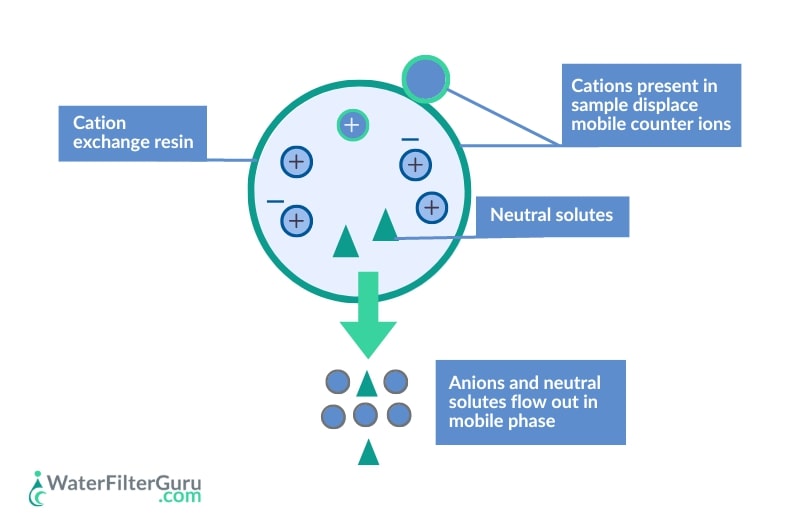
The Evidence
- A 2011 study on point-of-use devices for reducing manganese in drinking water found that under-the-sink filters using cationic exchange resins could efficiently remove dissolved manganese, but had a shorter operating life.
- A 2021 study on the use of two technologies for iron and manganese reduction concluded that cation exchange resin performed better than vermiculite clay when reducing lower concentrations of manganese – its highest manganese removal rates attained for the 5 PPM and 2 PPM were 99% and 100% respectively within the first 10–20 minutes.
Best For
Water softeners and cation exchange filters are a good solution for folks who have low levels of manganese in their water (no more than 1-2 PPM) and want to address this contaminant along with hard water minerals.
⚗️ Reverse Osmosis Systems
Manganese reduction rate: Up to 99.99% (when treating low levels)
Reverse osmosis is one of the most popular drinking water treatment options for purifying water, using an extremely thorough water treatment process that reduces the majority of dissolved solids, including manganese.
If your water has low levels of manganese, reverse osmosis should remove up to 99.99% of this metal ion.
We don’t recommend RO as primary treatment for well water containing high iron and manganese concentrations because of the potential for RO membrane fouling, which will significantly shorten its lifespan.
How it Works
There are several filter stages in a reverse osmosis purification system, including a sediment filter cartridge, an activated carbon filter, a semi-permeable membrane, and and post-filter.
RO membranes consist of tiny pores that act as a sieve – when water is pushed against the membrane, only water molecules are small enough to pass through, leaving the impurities to be flushed out of the system with a small amount of wastewater.
Reverse osmosis filtration systems are an overall effective water treatment option for reducing low levels of manganese, as well as lead, hydrogen sulfide, aesthetic impurities, chemicals, bacteria, arsenic, and VOCs.
Most reverse osmosis systems are point-of-use (either countertop or under-sink), but if you want to prevent the aesthetic effects of manganese around your home, you’ll need to install an RO unit at your home’s point of entry.
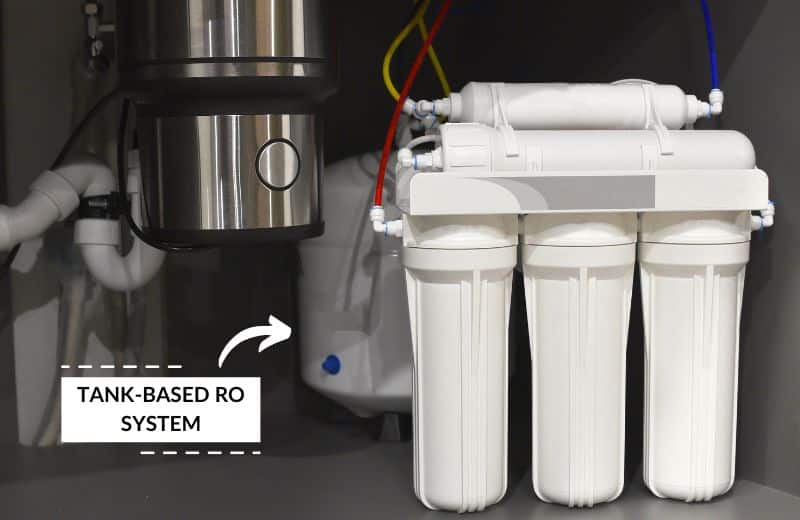
The Evidence
- A 2023 Brazilian evaluation of reverse osmosis in removing iron and manganese found that the RO process removed 99% of manganese from raw freshwater, concluding that RO is a “promising process” for the treatment of drinking water.
- Reverse osmosis is listed by the WQA as a proven water treatment technology for removing manganese from drinking water.
Best For
Reverse osmosis systems are the best solution for folks who want to remove low levels of manganese as well as purifying their water, greatly improving its quality and safety. Because of the high cost of POE RO, this method is better suited to people who just want to address taste issues with a POU system.
🔎 Other Treatment Methods That Remove Manganese
There are a few other methods that have shown promise in reducing or removing manganese, but, for one of several reasons, we don’t recommend them as our top choice.
These are:
- Sequestration – This process is most commonly used by water treatment plants and involves adding a chemical sequestrant into the water, causing manganese and iron to stabilize and disperse and preventing them from producing stains. Sequestration isn’t typically used as an at-home water treatment solution and doesn’t actually remove manganese (it just prevents its aesthetic effects), so we don’t recommend it amongst our top picks.
- Water distillers – Distillation systems are highly effective at purifying water, but the process of distilling water takes a very long time (up to 5 hours to distill 1 gallon). Plus, water distillers are typically point-of-use countertop systems, so they won’t prevent manganese staining around your plumbing system. There are more efficient alternatives to water distillers that we would recommend instead.
- Ultrafiltration – This process is similar to reverse osmosis, but ultrafiltration membranes have a larger pore size (around 0.02 microns vs RO’s 0.0001 microns). Ultrafiltration is another method highlighted by the American Water Works Association as being able to remove manganese, but UF membranes are less commonly available, which is why they didn’t make our list of top recommendations.
- Nanofiltration – Nanofilters have tiny pores that block most contaminants, including many metal ions. However, they’re predominantly used to filter sediment and microorganisms, and are typically found in emergency preparedness filters, so they’re not the best at-home water treatment method for removing manganese.
- KDF-85 – This type of KDF media can reduce many metal ions, including iron and manganese. It’s often combined with other filter media, like activated carbon, to remove additional contaminants. We didn’t list KDF media as a top method of manganese removal because we were unable to find much scientific evidence of the efficacy of this media for this purpose.
⚠️ Which Water Treatment Methods Are NOT Effective for Manganese Removal?
There are some water treatment options that can’t be used to reduce or remove manganese from a drinking water supply.
Activated Carbon
Activated carbon filters use a process called adsorption to remove select contaminants from water.
On its own, filter media typically doesn’t address metal or mineral ions, including manganese.
Catalytic Carbon
Catalytic carbon filters use modified activated carbon media, which has the ability to reduce additional contaminants like chloramine and hydrogen sulfide.
We found some sources claiming that catalytic carbon is slightly more effective than activated carbon at reducing low levels of manganese. However, it generally isn’t an effective way to remove manganese, and there are better alternatives to consider.
Ceramic Filters
Some countertop gravity-fed water filters and emergency preparedness filters use ceramic filtration media.
Ceramic filters can only address low levels of precipitated manganese, and can’t remove iron or manganese in an un-precipitated state.
Activated Alumina
In our research, we found that some modified or specially designed activated alumina filters are capable of reducing manganese.
However, the general consensus is that activated alumina’s main purpose is to reduce fluoride and arsenic.
Boiling Water
Boiling water kills microorganisms and causes chlorine and other volatile chemicals to dissipate.
However, you can’t boil water to remove manganese – this will simply cause some of the water to evaporate, leaving the same concentration of manganese in a smaller volume of water.
📑 Final Word
The right manganese-removing water filter for you depends on a few different factors – especially the concentration of manganese in your water.
Low levels of manganese can be effectively addressed with a cation exchange system, or, if you want to purify your water, a reverse osmosis system.
Otherwise, you’ll probably need to look at some form of oxidation system, which is more expensive but has the advantage of protecting your entire home from manganese staining and also addresses iron and hydrogen sulfide, making it a great choice for mineral-rich well water.
If you haven’t tested your water, start there. Once you know how much manganese is present, and which other contaminants are affecting your water quality, you’ll be better equipped to invest in the most suitable treatment solution.
Continue Reading:
🧠 How to Remove Manganese From Water: FAQ
Do water filters remove manganese?
Only certain water filters, like some KDF filters, cation exchange filters, and oxidation filters, remove manganese. Your typical activated carbon filter won’t remove manganese, although it might address tastes and smells associated with this contaminant.
Do all water softeners remove manganese?
Yes, all conventional water softeners that use cation exchange should address low levels of manganese in water. However, you may need a dedicated oxidation system, like an aeration system or a chemical injection system, if your water contains more than 1-2 PPM of this mineral.
What is the best system to remove manganese?
Based on our own research and testing, we think the best system to remove manganese is an oxidation and filtration system. This system uses oxygen or chemicals like chlorine to oxidize the manganese, converting it into an insoluble form that can then be filtered out when water passes through a filter bed.
What dissolves manganese?
Nothing dissolves manganese in the sense of causing it to dissipate out of water or simply disappear. However, there are certain methods of oxidizing manganese, which alters its form and enables it to be removed with filtration. Chemicals like chlorine bleach, ozone, and potassium permanganate are effective for this purpose.

